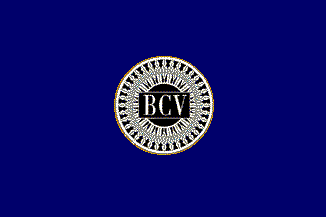
image by Guillermo T. Aveledo, 21 December 1999

Last modified: 2014-05-22 by zoltán horváth
Keywords: venezuela | bank | comptroller | police | petroleum |
Links: FOTW homepage |
search |
disclaimer and copyright |
write us |
mirrors

image by Guillermo T. Aveledo, 21 December 1999
Banco Central de Venezuela (Central Bank of Venezuela) :
Description: A Dark Blue field, with the Seal of the Banco
Central de Venezuela (BCV) centered on it. This seal mimicks a
coin, and it is usually black with embroiderments of white,
encircled in ocre. There is also a coloured version of the Seal,
also used on flags (haven't found it yet).
Guillermo T. Aveledo, 21 December 1999
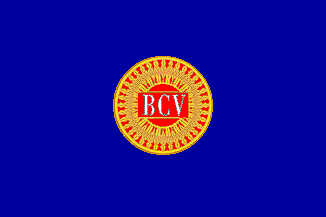
image by Guillermo T. Aveledo, 1 March 2000
This is a variant of the flag of Venezuela's Central Bank.
This one, instead of a black and white seal has an ocre and red
seal. Both variants are usually hoisted alternatively with no
protocol which would specify their different meanings (if any).
Word is up that a slight change in the flag's logo is coming...
Guillermo T. Aveledo, 1 March 2000
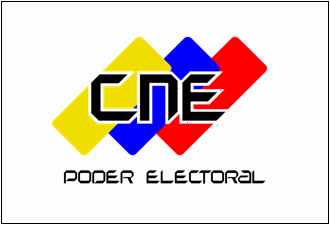
image by Raul Orta, 14 November 2007
The Flag of Consejo Nacional Electoral: white field
with the official logotype of the organization on the
center.
Raul Orta, 14 November 2007
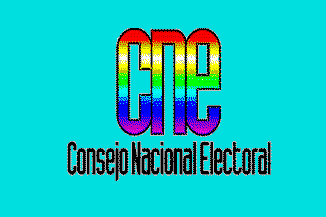
image by Guillermo T. Aveledo, 1 June 2000
The flag of the Consejo Nacional Electoral, head of the
Electoral Power in Venezuela. Logo designed in 1997 by Santiago
Pol. The flag is decorative, for standing pole rather than to be
flown. The Consejo Nacional Electoral, the main electoral
authority in Venezuela.
Guillermo T. Aveledo, 1 June 2000
The CNE (Consejo Nacional Electoral, National Electoral Council) is the
institution in charge of all electoral processes that take place in Venezuela.
It was established on September 11, 1936 through the Ley de Censo Electoral y de
Elecciones (Law of Electoral Census and Elections).
Sources:
http://www.cne.gov.ve/web/la_institucion/antecedentes.php
http://en.wikipedia.org/wiki/National_Electoral_Council_(Venezuela)
http://es.wikipedia.org/wiki/Consejo_Nacional_Electoral_(Venezuela)
Its flag is a silver horizontal flag, with the logo in the middle (the logo
displaying the initials CNE in black capital letters), as seen
here (flag on the
right)
Esteban Rivera, 27 September 2010
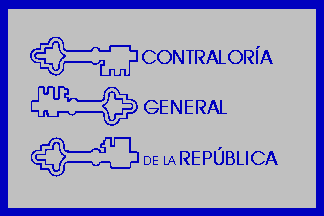
image by Guillermo T. Aveledo, 1 March 2000
General Comptroller Office flag:
A grey field framed by a thin blue band (this is not a fringe;
it's part of the flag), and inside it the semblem of the General
Comptroller's Office: the THREE KEYS, and the words
"Contralori'a General de la Repu'blica" (CGR), in blue.
This Comptroller's Office wwas created as the "Contralor?a
Nacional" in 1938, receiving its current name with the
framing of the 1961 constitution, which has remained after the
drafting of the New Constitution of 1999. This flag flies outside
the building of the CGR, its pole being diagonally attached to
the building itself, whereas a national flag is hoisted on its
own sanding polea few meters in front of the building (a must
according to the Venezuelan Flag Law).
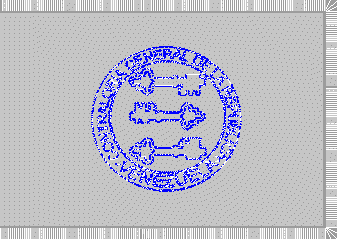
image by Guillermo T. Aveledo, 1 March 2000
General Comptroller flag:
This flag, all grey, has a lighter grey fringe (being usually a
desktop, or an office flag, not a flag to be hoisted ouiside),
made out of shiny taffeta, and iwth the CGR's seal embroidered on
its center. The seal consists of two concentric circles of blue,
and the words "Contralori'a General de la Repu'blica -
Venezuela" arranged in circular fashion inside the outer
circle. Inside the inner circle, we can see the CGR's Three Keys.
The Symbol of the Three Keys :
The first book of the Real Hacienda of the Venezuelan Provoince
dates from the 29th of April of 1529, and it starts with an
"account of the money collected by Juan de Amp?es and its
people while Governor Micer Ambrosio landed on this land".
Two months after the arrival on the first Belzares expedition,
captained by Governor Ambrosio Alfinger, in Coro (the the capital
of the province of Venezuela, the first registers of the Real
Hacienda take place, under the supervision of a
"Treasurer", an "Accountant" , a "Writer
and Observer". The functions of these three Royal Officials
was ruled by a 'Cedula Instruccio'n' issued by the Queen Jane of
Spain (Juana la Loca) the 17th of February of 1531. The Cedula
said especifically that the three Royal Officers had a duty
to deposit on a Coffin "all the gold a pearls belonging to
the King". The Coffin had three keys with three diferent
locks, each of the Royal Officials being issued with one of the
keys. It was warned that no one could substract "no gold, no
pearl, no coin" from the Coffin without the agreement and
presence of the three Royal Officers, as a way to avoid fraud and
mishandling of funds. The three Royal Officers also kept each a
separate book reccording the accounts of the coffin, whose
contents wer transcribed later to a General and Common Book of
Control. And nothing could be taken away od deposited in the
Royal Coffin without being entered in such a book, and this under
the presence of the Governor.
The Real Cedula of the 17th of February of 1531 serves as a
revealing document of the care and vigilance which Spain exerted
over the control and handling of her administration and of her
ultramarine posessions. It is, in fact, a historical precedent,
obvious differences aside, if what is and represents the General
Comptroller's Office. Hence, the symbol of the Three Keys.
Manuel Trujillo. Archivo Histo'rico de la CGR (adapted
and translated by Guillermo Aveledo)
Jaume Ollé asked:
Can you check if the writing in the flag of the Controladuria
General de la Republica is correct. The word
"contraloria" seems a bit strange.
And Santiago Dotor replied:
As far as I know "Contraloria" is perfectly correct in
South America. There is no fully equivalent term in Spain, and we
would call this "Tribunal de Cuentas" and/or
"Intervenci?n General del Estado". And I guess the
leading officials in that organisation are
"contralores" which in Spain would be
"interventores".
The term is indeed "contraloria". But yes, it sounds
funny and its very difficult to translate properly; now the
situation has worsened because the status of the Contraloria
[which I had named Comptroller's office] has been altered under
the new Venezuelan Constitution of 1999. No changes on the flag,
though (but a very slight modification of the dimensions might be
ordered). The term might be that strange, since it is originally
a French word. I checked the DRAE (Diccionario de la Ral Academia
Espan~ola), and it said as follow in my rough translation:
"CONTRALORIA. (From contralor [which comes from the French
'controleur'] fem. In some American countries, a service in
charge of examining the legality and correctness of public
expenditure."
Perhaps "Controladur?a" would be a more correct term
for Spanish use, but I guess French jurisprudence and
constitutional doctrine shaped our legal framework in the past
century more than Spanish law did.
Guillermo T. Aveledo , 25 March 2000
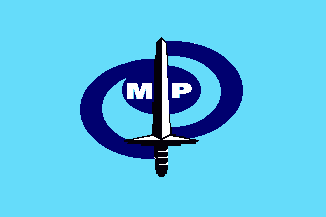
image by Guillermo T. Aveledo, 16 September 2000
Venezuela - Fiscali'a General de la Repu'blica. Ministerio
Pu'blico - Venezuela: General Attorney's Offiice. Public Ministry
Guillermo T. Aveledo, 16 September 2000
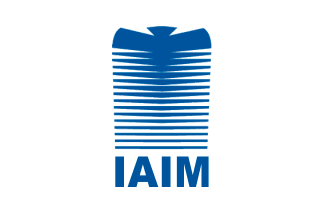
image by Zoltan Horvath, 22 February 2014
The IAIM (Instituto Aeropuerto Internacional de Maiquetía, Maiquetia
International Airport Institute) is the operator of the
"Aeropuerto Internacional de Maiquetía Simón Bolívar" in Maiquetía,
Estado Vargas.
Source:
http://es.wikipedia.org/wiki/Instituto_Nacional_de_Aeron%C3%A1utica_Civil
The flag is a white horizontal flag with the
logo
in the middle.
The flag is seen
here
and
here.
(Sources:
http://www.gentedehoy.com/site/2013/08/designado-gb-luis-gustavo-graterol-caraballo-como-presidente-de-conviasa/
and http://www.aporrea.org/actualidad/n234125.html )
For additional information go to:
IAIM (official website):
Aeropuerto Internacional de Maiquetía "Simón Bolívar" (official website)
Esteban Rivera, 22 February 2014

image by Zachary Harden, 20 December 2004
Based on <www.lacasadelasbanderas.com>.
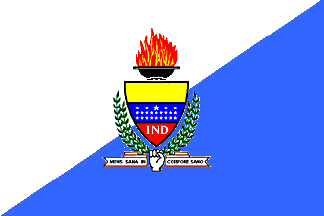
Flag
image by Ivan Sache, 27 May 2004
ind.gif)
Coat of Arms
image by Raul Orta, 28 April 2004
Flag at <www.lacasadelasbanderas.com>.
Logo at <www.ind.gov.ve>.
Dov Gutterman and Marc Pasquin, 13 April 2004
Instituto Nacional de Deportes (National Institute of Sports)
- Official organization which centralizes all the sport activity
in our country.
The Flag - Attributes and Semiology: Consists in a field with
approximated ratio 2:3; this is, square and half of length,
diagonally divided from the superior corner of the fly to
the inferior corner of the hoist in two triangular stripes:
white (superior) and blue (inferior). Completes the design the
Coat of Arms of the Institute on the center. Although at the time
of the redaction of this file is not available official data
about the semiology of this flag, according to the consulted
sources, the generally attributed meaning to these colors is the
follows: white remembers Integrity, Virtue and Peace whereas blue
alludes to High Ideals, Elevation of Sights, Justice, Loyalty and
Perseverance, values all totally adapt with the aims and
objectives of the Organism. This piece is considered too
the Venezuelan Sport Flag.
Historical Synthesis: Until the moment of the redaction of this
file is not available data about the origin and official adoption
of this flag.
Coat of Arms - Attributes: Consists of a French contour tierced
in fess. The Quarter of the Chief, is plenty in Or (yellow). The
Central Quarter, enameled in Azure (blue) charges twenty-three
five-pointed stars in Argent (white) disposed five, nine and
nine, being of greater dimension the central one in the set of
five. The Quarter of the Base, enameled in Gules (red) loads the
abbreviations "I", "N" and "D" in
Roman capital letters of Argent (white). As external ornaments,
the blazon shows a censer in Sable (black) flamed (with flames)
in Or (yellow) and Gules (red) as crest and as supports, a laurel
crown in its colors and a pennant in Argent (white) charging the
motto 2MENS SANA IN CORPORE SANO" (Healthy Mind in
Healthy Body) in gothic capital letters in Sable (black), both
subjects by a human dexter in Argent (white) filleted
(delineated) in Sable (black).
Semiology: Although at the time of the redaction of this file is
not available official data about the matter, according to the
consulted sources is possible to be inferred that the enamels in
the quarters allude to the National Flag of Venezuela: Or
(yellow) remembers Authority, Magnanimity and Constance; Azure
(blue) alludes to High Ideals, Elevation of Sights, Justice,
Loyalty and Perseverance, while Gules (red) represents Courage,
Sacrifice and Valor, all of them virtues totally adapted with the
aims and objectives of the Organism. The stars represent the
twenty-three geopolitical entities of the Republic, whereas the
abbreviations allude naturally to the Institute. The flamed
censer remembers the Sports Spirit; the laurel crown symbolizes
the imperishable triumph fruit of the maintained effort; the
closed hand symbolizes strength and victory, whereas the motto,
take from the well-known phrase of the Latin poet Juvenal,
rebounds the same essence and fundamental object of the Organism.
Historical Synthesis: Until the moment of the redaction of this
file is not available data about the origin and official adoption
of this Coat of Arms.
Sources: Material and information provided by Mr.
Konstantin Jemetz, Functionary in Charge of Documentation of
Literature Room and Superior University Technician Richard
Idrogo, Graphical Designer of Department of Press of
National Institute of Sports. Caracas, April 21st, 2004.
Raul Orta, 28 April 2004
The Latin poet Juvenal (Decimus Junius Juvenalis, c.
60-c. 130) came from Apulia to Rome under the reign of emperor
Domitian (Titus Flavius Domitianus, 51-96, emperor in
81). He spent a harsh life, always searching for rich protectors.
Embittered by his setbacks, he wrote in the beginning of the IInd
century sixteen Satires, in which he violently denounced
the moral corruption of the Roman society. Juvenal venerated the
traditional moral and social values and accusated the foreigners
and the emancipated slaves to contribute to the degeneracy of
these values. Juvenal is considered as one of the founders of the
satire, characterized by the lack of nuance and deliberately
exaggerated indignation. Among those who acknowledged his
influence are the French satirists Nicolas Boileau (1636-1711)
and Victor Hugo (1802-1885).
Mens sana in corpore sano appears in Satire X
(356), dedicated to the wishes. Originally, Juvenal meant that,
as a wise man, he asked to the God only a healthy mind and a
healthy body. The modern meaning of the maxima is rather that a
healthy body is required to have a healthy mind. Therefore, it is
not surprising that Juvenal's maxima is used as a mantra by sport
federations. I believe the use of supposed wise Latin mottos by
the sport federations is extremely ironical knowing the level of
mind and body corruption attained in modern sport.
Ivan Sache, 27 May 2004
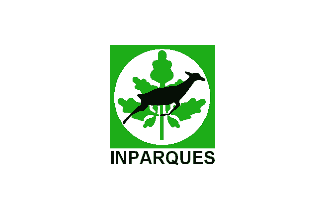
image by Guillermo T. Aveledo, 1 March 2000
Instituto Nacional de Parques (INPARQUES, National Park
Institute) - The INPARQUES logo, with the letters MARNR (Ministry
of Environment and Renewable Natural Resources). The logo is a
black deer passant (modernly stylised) on a tree leaf .
Now, the names and initials of many ministries (including this)
have changed, but no flag has done any changes
Guillermo T. Aveledo, 1 March 2000
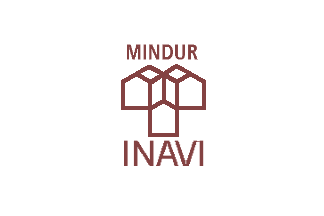
image by Guillermo T. Aveledo, 1 March 2000
Instituto Nacional de la Vivienda (INAVI, National Housing
Institute) - The INAVI logo (three crossed gibblings which look
like houses), and the letters MINDUR above it (Ministry of Urban
Development), in brown.
Now, the names and initials of many ministries (including this)
have changed, but no flag has done any changes
Guillermo T. Aveledo, 1 March 2000
The "Cuerpo Tecnico de Polici'a Judicial" (CTPJ) is the national investigative police in Venezuela, closely linked to the Judicial Power and to the whole procces of enforcing Penal Law. It has two flags, a flag for the Central Office and representative of the institution itself, and a branch flag (not official, only drawn from my observations).
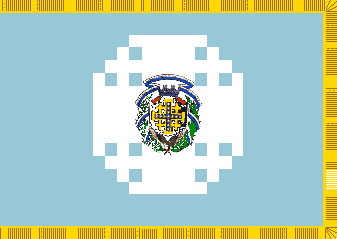
image by Guillermo T. Aveledo, 1 March 2000
The CTPJ Flag consists of a sky blue field represents marian (after Virgin Mary, of the Catholic faith) and the white cross (of Jerusalem) represests devotion and the spirit of sacrifice which must caracterise and be a mark of every man and woman belonging to the CTPJ. On the center of the cross, we see the CPTJ's Coat of Arms:
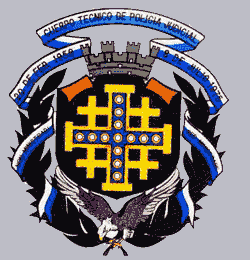
The Coat of Arms
image by Guillermo T. Aveledo, 1 March 2000
The Coat of Arms - sabre fielded shield, as a symbol of hte
impetuosity of police soul. It is not a parted field (symbolising
the unity of the police body and the competence of the STPJ all
over the Venezuelan Territory). A quartered golden cross sits at
the center of the shield, and from its centre, golden rays gleam
to the different extremes of the cross (and of the four smalle
crosses annexed to it, representing honesty, heroism, loyalty and
total surrender of the self to virtue). Crowning the whield we
see a mural crown (similar to those on Portuguese municipal flags
and to that of Venezuela's National Guard), with four turrets,
simbolising the reward for the bravery, the boldness and the
perseverance which are kry to the triumph of good over evil.
Below, we there's a flying eagle, as a symbol of the
sagaciousness and firmness necessary in the pursue of police
duties, to subdue evildoers. The two lauril branches along the
seides of the shield incarnate the hopes on achieving goals and
the reward for heroic action. Finally, encricling the shield, we
see a band with marina colours (blue-white), which identify
the CTPJ. We see on this band the date of foundation of the CTPJ
(February 20th, 1958), and the date of the passing of the Law onf
Judicial Police, (July 8th, 1975). From left to right and hugging
the lauril branches we can read the phrase "Non ministrare,
Sed ministrare" (Not to be served but to serve).
Guillermo T. Aveledo , 1 March 2000
I located this flag but as National Direction of Penal
Investigations at <www.ctpj.gov.ve>.
Here is a Altavista translation:
FLAG - It is the standard that represents the honor and the
highest values of the National Direction of Penal Investigations.
The celestial blue bottom incarnates the marianos colors and the
white cross means the devotion and the spirit of sacrifice that
must characterize and distinguish all man and woman whom part of
the Institution forms. The own and exclusive character of the
National Direction of Penal Investigations, is identified when
taking the Shield of Arms in the central part of the Flag
totally.
The Shield of Arms has a bottom field, color saber (black), that
it wants to symbolize reciedumbre of the Police Core. This field
is not divided nor is divided, thus wanting to symbolize the unit
of the Body and the Police competition that the Venezuelan
national territory has mainly. In the center of this field, it
goes like figure, a cantonada enamel cross metal gold, formed by
a great Greek cross. There from the center of the great cross
they leave to rays for the ends, also covering other four small
inserted Greek crossings. The cantonada cross is one of oldest
than it is known in the Christian world. It is a sacred symbol.
With her it is wanted to represent the heroic acts inspired by
the search of an ideal, without repairing in difficulties nor
sacrifices, separating all idea from profit and personal
interest, the sacrifice and the honor of the police civil
employee. The four small crossings mean the virtues of the
heroísmo, loyalty, the honesty and the total delivery to the
service. In the superior part it is the crown mural, that
symbolizes the glory, the prize to I throw, the value and
certainty that determine the triumph of the good in the fight
against badly. In the inferior part it is the rampante eagle
symbolizing the necessary sagacidad and the firmness in the
fulfillment of having police officer, to reduce to the
malefactors. The two branches of laurel of the flanks incarnate
the hope in the profits and the prize to the heroic actions.
Finally, bordering the shield, a tape with the marianos colors is
seen, blue and white that identify our Institution. In her we can
read the date of the foundation of the National Direction of
Penal Investigations: 20 of February of 1958 and the date in
which the Law of Judicial Police was promulgated: 8 of Julio of
1975. Of right to left and more down, it is reflxed mng in Latin
" Non Ministrari, Thirst Ministrare ", that in Spanish
means: Not to be served but to serve, motto that must at any
moment have the police civil employee like north of its acts.
"
Dov Gutterman, 21 January 2002
The National Direction of Penal Investigations was formerly
known as the CTPJ or Cuerpo Tecnico de Policia Judicial
(Technical Body of Judicial Police). I'm sure the CoA will have
to change (since it says Cuerpo Tecnico de Policia Judicial in
the white-blue band encricling the shield).
The NDPI changed from the former CPTJ late in 2001. I was
expecting a thorough symbol change, but nothing has happened so
far.
Guillermo T. Aveledo, 5 March 2002
Radio Club Venezolano flag can be seen at <www.radioclubvenezolano.org>.
Dov Gutterman, 1 June 2001

image by Zoltan Horvath, 25 March 2011
The SUDEBAN (Superintendencia de Bancos), Banking Superintendency is the
Venezuelan government organization in charge of regulating Banks practices.
Source:
http://sudeban.gob.ve/webgui/inicio/quienes
Its flag is a white horizontal flag with the
logo in the middle.
Image of flag at:
http://www.abrebrecha.com/110735_Norma-para-enfrentar-ciberdelitos-prepara-Sudeban.html
For additional information please see:
SUDEBAN (official
website)
Esteban Rivera, 25 March 2011